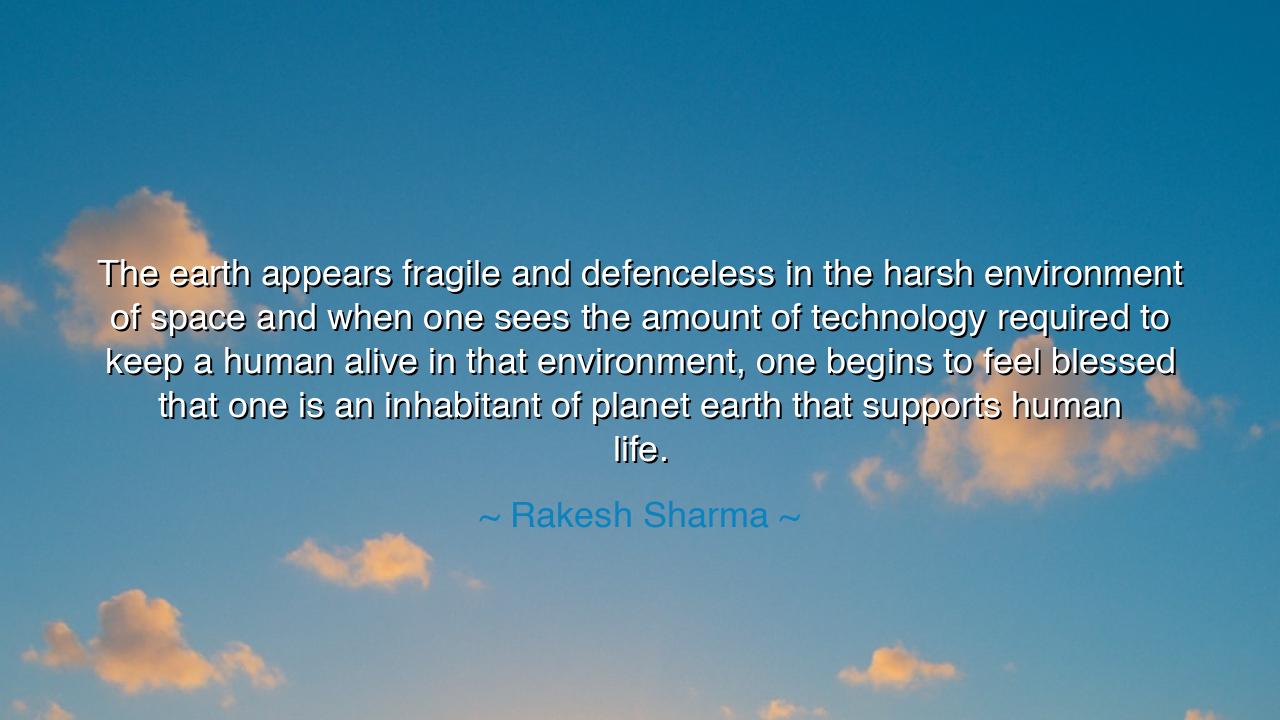
The earth appears fragile and defenceless in the harsh
The earth appears fragile and defenceless in the harsh environment of space and when one sees the amount of technology required to keep a human alive in that environment, one begins to feel blessed that one is an inhabitant of planet earth that supports human life.






In the vast expanse of the cosmos, where the heavens stretch beyond the reach of our understanding, the Earth appears as a fragile, defenceless orb, floating in the endless void of space. The words of Rakesh Sharma, the first Indian astronaut, “The earth appears fragile and defenceless in the harsh environment of space and when one sees the amount of technology required to keep a human alive in that environment, one begins to feel blessed that one is an inhabitant of planet earth that supports human life,” are a reflection on the incredible delicacy of our existence. These words speak to a profound truth—the Earth, in its beauty and balance, supports life, yet it is so vulnerable in the grand scheme of the universe.
The fragility of Earth becomes evident when we look up at the vastness of space. The Earth, in its breathtaking beauty, spins through the universe, held in balance by the forces of nature—gravity, atmosphere, and the delicate interplay of elements that sustain life. Space, however, is a hostile environment, where the absence of air, the lack of water, and the extremes of temperature create a near-impossible setting for survival. The challenges of surviving in space are vast—life support systems, space suits, and technological marvels are all required to keep a human being alive and functioning. The fact that we live on a planet that provides us with breathable air, sustenance, and shelter is a gift so often overlooked in the rush of our daily lives.
Rakesh Sharma’s experience in space—the infinite emptiness surrounding him, the view of Earth from the cosmic perspective—reveals the astonishing reality of our existence. The Earth’s life-supporting properties—the atmosphere that shields us from the sun’s harsh rays, the oceans that nourish us, the mountains and forests that provide shelter and resources—become all the more remarkable when seen against the backdrop of space’s hostility. The human body, delicate and vulnerable as it is, could not survive without the protection and nourishment that Earth provides. In space, human survival requires more than mere flesh and bones; it requires a vast web of technology to ensure oxygen, water, and food, and to regulate temperature. It is a reminder that life on Earth is, in many ways, a miracle, sustained by forces that we often take for granted.
Let us look to the ancient wisdom of the philosophers, who spoke of the Earth as a sacred and interconnected whole. The Greeks viewed the Earth as Gaia, a living being that sustains all life. The balance of nature, they understood, was sacred, and the Earth was a reflection of the divine order of the universe. When Pythagoras spoke of the harmony of the cosmos, he saw the Earth’s balance as part of the greater universe’s order, where every element played its role in sustaining life. The fragility of life on Earth was not seen as a weakness, but as part of the beauty of the cosmos—a beauty that humankind must respect and preserve.
In our modern age, we have come to realize the vast importance of preserving the Earth in the face of climate change, pollution, and the overconsumption of its resources. The technological advances that allow us to explore the cosmos should serve as a reminder of how precious the Earth is. As we venture further into space, we must be ever more conscious of our duty to nurture and protect the planet that sustains us. To see Earth from space, as Sharma did, is to understand in a deeply personal way how small and vulnerable it is—a speck in the universe that holds the miracle of life. It is a call to remember that while we may look to the stars, the Earth is our home, and it is our responsibility to care for it.
The lesson here is not just one of awe and gratitude for the life-sustaining forces of Earth, but also of responsibility. As we continue to push the boundaries of human knowledge and exploration, we must also push the boundaries of our commitment to preserving the Earth’s fragile ecosystems. Our technology, while remarkable, cannot replace the natural balance that the Earth provides. If we wish to ensure that future generations can breathe, drink, and thrive on this planet, we must learn to live in harmony with it, to tread lightly, and to protect what we have been entrusted with.
As Sharma’s words remind us, we are all blessed to live on this planet, but we must never forget that blessing comes with a deep sense of responsibility. Let us cherish the fragility of Earth and protect its delicate balance, for in doing so, we ensure that life—in all its forms—continues to flourish. The Earth, with all its wonders, is the cradle of humanity, and it is our sacred duty to nurture and preserve it for the generations to come. May we never lose sight of the miracle that it is to live here, on this fragile and beautiful planet.






AAdministratorAdministrator
Welcome, honored guests. Please leave a comment, we will respond soon